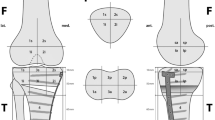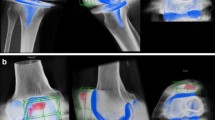Abstract
Purpose
The primary purpose of this retrospective study was to evaluate the differences of bone tracer uptake (BTU) in symptomatic and asymptomatic knees after bilateral total knee arthroplasty (TKA) and identify typical BTU patterns with regards to TKA component position and alignment.
Methods
A consecutive number of 37 patients after bilateral TKA were retrospectively included. The knees were grouped into symptomatic (group A) and asymptomatic (group B) knees. All patients underwent 99m-Tc-HDP-SPECT/CT. Coronal, rotational, and sagittal TKA component position was analysed in 3D reconstructed CT. BTU was anatomically localised and quantified using a validated standardized localization scheme. Maximum BTU values for each area were recorded and normalized values calculated. Signed log-rank test, chi-square test, paired t-tests, and Pearson correlations were used (p <0.05).
Results
Symptomatic TKAs were significantly more flexed and had a tendency to be more internally rotated when compared to asymptomatic ones (p < 0.05). In all regions, the mean BTU in asymptomatic knees was lower than in symptomatic knees. In both groups the highest mean BTU was found around the tibial stem (symptomatic 7.30; asymptomatic 6.30, p = 0.061) and at the tip of the tibial stem (symptomatic 5.49; asymptomatic 4.74, p = 0.062). Superior patellar regions showed higher BTU than inferior regions. The highest patellar BTU was found in the superior medial patella (symptomatic 4.99; asymptomatic 3.98, p = 0.048). The lowest BTU was found in the posterior femoral regions (flatsp, flatip, fmedsp, fmedip) (Table 3). Tibial and patellar areas showed twice as high mean BTUs than femoral areas (Fig. 3). A significant correlation of TKA component position and BTU was demonstrated.
Conclusions
Distribution and intensity of BTU in SPECT/CT depends on TKA component position and alignment. In addition, typical BTU patterns in symptomatic and asymptomatic knees were identified. A profound knowledge of BTU pattern, TKA component position, and alignment helps to identify pathologies in patients after TKA.
Clinical evidence
Diagnostic study, level II





Similar content being viewed by others
References
Becker R, Bonnin M, Hofmann S. The painful knee after total knee arthroplasty. Knee Surg Sports Traumatol Arthrosc. 2011;19(9):1409–10.
Becker R, Doring C, Denecke A, Brosz M. Expectation, satisfaction and clinical outcome of patients after total knee arthroplasty. Knee Surg Sports Traumatol Arthrosc. 2011;19(9):1433–41.
Fehring TK. Rotational malalignment of the femoral component in total knee arthroplasty. Clin Orthop Relat Res. 2000;380:72–9.
Hofmann S, Seitlinger G, Djahani O, Pietsch M. The painful knee after TKA: a diagnostic algorithm for failure analysis. Knee Surg Sports Traumatol Arthrosc. 2011;19(9):1442–52.
Porteous AJ. Failed TKA- causes, assessment & algorithm. Instructional Course Knee Surgery- from Complex Primary to Revision 17.-18.10.2013: Smith&Nephew Medical Education; 2013.
Mandalia V, Eyres K, Schranz P, Toms AD. Evaluation of patients with a painful total knee replacement. J Bone Joint Surg (Br). 2008;90(3):265–71.
Toms AD, Mandalia V, Haigh R, Hopwood B. The management of patients with painful total knee replacement. J Bone Joint Surg (Br). 2009;91(2):143–50.
Hirschmann MT, Henckel J, Rasch H. SPECT/CT in patients with painful knee arthroplasty-what is the evidence? Skelet Radiol. 2013;42(9):1201–7.
Hirschmann MT, Amsler F, Rasch H. Clinical value of SPECT/CT in the painful total knee arthroplasty (TKA): a prospective study in a consecutive series of 100 TKA. Eur J Nucl Med Mol Imaging. 2015. doi:10.1007/s00259-015-3095-5.
Mucha A, Dordevic M, Hirschmann A, Rasch H, Amsler F, Arnold MP, et al. Effect of high tibial osteotomy on joint loading in symptomatic patients with varus aligned knees: a study using SPECT/CT. Knee Surg Sports Traumatol Arthrosc. 2015;23(8):2315–23.
Schon SN, Afifi FK, Rasch H, Amsler F, Friederich NF, Arnold MP, et al. Assessment of in vivo loading history of the patellofemoral joint: a study combining patellar position, tilt, alignment and bone SPECT/CT. Knee Surg Sports Traumatol Arthrosc. 2014;22(12):3039–46.
Rasch H, Falkowski AL, Forrer F, Henckel J, Hirschmann MT. 4D-SPECT/CT in orthopaedics: a new method of combined quantitative volumetric 3D analysis of SPECT/CT tracer uptake and component position measurements in patients after total knee arthroplasty. Skelet Radiol. 2013;42(9):1215–23.
Hirschmann MT, Schon S, Afifi FK, Amsler F, Rasch H, Friederich NF, et al. Assessment of loading history of compartments in the knee using bone SPECT/CT: a study combining alignment and 99mTc-HDP tracer uptake/distribution patterns. J Orthop Res. 2013;31(2):268–74.
Hirschmann MT, Mathis D, Rasch H, Amsler F, Friederich NF, Arnold MP. SPECT/CT tracer uptake is influenced by tunnel orientation and position of the femoral and tibial ACL graft insertion site. Int Orthop. 2013;37(2):301–9.
Hirschmann MT, Mathis D, Afifi FK, Rasch H, Henckel J, Amsler F, et al. Single photon emission computerized tomography and conventional computerized tomography (SPECT/CT) for evaluation of patients after anterior cruciate ligament reconstruction: a novel standardized algorithm combining mechanical and metabolic information. Knee Surg Sports Traumatol Arthrosc. 2013;21(4):965–74.
Hirschmann MT, Iranpour F, Konala P, Kerner A, Rasch H, Cobb JP, et al. A novel standardized algorithm for evaluating patients with painful total knee arthroplasty using combined single photon emission tomography and conventional computerized tomography. Knee Surg Sports Traumatol Arthrosc. 2010;18(7):939–44.
Strobel K, Steurer-Dober I, Huellner MW, Veit-Haibach P, Allgayer B. Importance of SPECT/CT for knee and hip joint Prostheses. Radiologe. 2012;52(7):629–37.
Al-Nabhani K, Michopoulou S, Allie R, Alkalbani J, Saad Z, Sajjan R, et al. Painful knee prosthesis: can we help with bone SPECT/CT? Nucl Med Commun. 2014;35(2):182–8.
Graute V, Feist M, Lehner S, Haug A, Muller PE, Bartenstein P, et al. Detection of low-grade prosthetic joint infections using 99mTc-antigranulocyte SPECT/CT: initial clinical results. Eur J Nucl Med Mol Imaging. 2010;37(9):1751–9.
Huellner MW, Burkert A, Schleich FS, Schurch M, Hug U, von Wartburg U, et al. SPECT/CT versus MRI in patients with nonspecific pain of the hand and wrist - a pilot study. Eur J Nucl Med Mol Imaging. 2012;39(5):750–9.
Hirschmann MT, Iranpour F, Davda K, Rasch H, Hugli R, Friederich NF. Combined single-photon emission computerized tomography and conventional computerized tomography (SPECT/CT): clinical value for the knee surgeons? Knee Surg Sports Traumatol Arthrosc. 2010;18(3):341–5.
Hirschmann MT, Konala P, Iranpour F, Kerner A, Rasch H, Friederich NF. Clinical value of 99mTc-HDP-SPECT-CT for assessment of patients with painful knees after total knee arthroplasty - a new dimension of diagnostics. BMC Musculoskelet Disord. 2011;4:12–36.
Hirschmann MT, Wagner CR, Rasch H, Henckel J. Standardized volumetric 3D-analysis of SPECT/CT imaging in orthopaedics: overcoming the limitations of qualitative 2D analysis. BMC Med Imaging. 2012;12(1):5.
Hirschmann MT, Konala P, Amsler F, Iranpour F, Friederich NF, Cobb JP. The position and orientation of total knee replacement components: a comparison of conventional radiographs, transverse 2D-CT slices and 3D-CT reconstruction. J Bone Joint Surg (Br). 2011;93(5):629–33.
Fang DM, Ritter MA, Davis KE. Coronal alignment in total knee arthroplasty: just how important is it? J Arthroplasty. 2009;24(6 Suppl):39–43.
Hungerford DS. Alignment in total knee replacement. Instr Course Lect. 1995;44:455–68.
Berger RA, Rubash HE, Seel MJ, Thompson WH, Crossett LS. Determining the rotational alignment of the femoral component in total knee arthroplasty using the epicondylar axis. Clin Orthop Relat Res. 1993;286:40–7.
Akagi M, Matsusue Y, Mata T, Asada Y, Horiguchi M, Iida H, et al. Effect of rotational alignment on patellar tracking in total knee arthroplasty. Clin Orthop Relat Res. 1999;366:155–63.
Anouchi YS, Whiteside LA, Kaiser AD, Milliano MT. The effects of axial rotational alignment of the femoral component on knee stability and patellar tracking in total knee arthroplasty demonstrated on autopsy specimens. Clin Orthop Relat Res. 1993;287:170–7.
Boldt JG, Stiehl JB, Hodler J, Zanetti M, Munzinger U. Femoral component rotation and arthrofibrosis following mobile-bearing total knee arthroplasty. Int Orthop. 2006;30(5):420–5.
Benjamin J. Component alignment in total knee arthroplasty. Instr Course Lect. 2006;55:405–12.
Bindelglass DF. Rotational alignment of the tibial component in total knee arthroplasty. Orthopedics. 2001;24(11):1049–51. discussion 51-2.
Lemaire P, Pioletti DP, Meyer FM, Meuli R, Dorfl J, Leyvraz PF. Tibial component positioning in total knee arthroplasty: bone coverage and extensor apparatus alignment. Knee Surg Sports Traumatol Arthrosc. 1997;5(4):251–7.
Uehara K, Kadoya Y, Kobayashi A, Ohashi H, Yamano Y. Bone anatomy and rotational alignment in total knee arthroplasty. Clin Orthop Relat Res. 2002;402:196–201.
Nicoll D, Rowley DI. Internal rotational error of the tibial component is a major cause of pain after total knee replacement. J Bone Joint Surg (Br). 2010;92(9):1238–44.
Author information
Authors and Affiliations
Corresponding author
Ethics declarations
Conflict of interest
Author RA, HR, FA, and MTH declare that they have no conflict of interest. Ethical approval: All procedures performed in studies involving human participants were in accordance with the ethical standards of the institutional and/or national research committee and with the 1964 Helsinki declaration and its later amendments or comparable ethical standards.
Informed consent
Informed consent was obtained from all individual participants included in the study.
Rights and permissions
About this article
Cite this article
Awengen, R., Rasch, H., Amsler, F. et al. Symptomatic versus asymptomatic knees after bilateral total knee arthroplasty: what is the difference in SPECT/CT?. Eur J Nucl Med Mol Imaging 43, 762–772 (2016). https://doi.org/10.1007/s00259-015-3278-0
Received:
Accepted:
Published:
Issue Date:
DOI: https://doi.org/10.1007/s00259-015-3278-0




